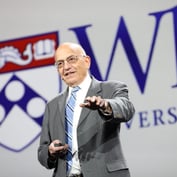I can summarize my strategy to get your clients to volunteer more referrals in seven words: Advice, TOMA, Engagement, Promote and Thank You.
I covered two of those parts — Advice and TOMA (top-of-mind awareness). You can find part one of the series here.
To summarize: If you fail to provide good investment advice for, let’s say, a year or so, you can survive if your relationships are solid. Referrals will, however, dry up, so advice is vital. While good investment advice does not guarantee referrals, bad advice will bring them to a screeching halt.
TOMA, like all the ingredients in this recipe, also is critical. It’s defined as “that thought which first occurs to someone when presented with a category.”
Suppose your client’s brother-in-law says, “Liz and I are not happy with our financial advisor. Do you have someone you could recommend?” Your client, who works with two other advisors, better think of you first! When TOMA kicks in, you get the referral — not the other advisors.
Who Refers?
Onto the third word, engagement.
It’s maddening, isn’t it? You have done a great job for Bob and Liz Barking. Their portfolio has grown consistently with only occasional dips. He is the managing director of a midsize law firm, while she is an ophthalmologist. Between them, they are earning high six figures.
But nary a referral has passed their lips. They are happy, but they do not refer. Why?
First of all, they might have referred you. You just don’t know it. Here are the numbers.
“Seventy-seven percent of clients give their advisor an average satisfaction rating of eight out of 10 or higher. Ninety-three percent of clients are somewhat or extremely likely to continue working with their advisor. Eighty-three percent are comfortable providing a referral. Twenty-nine percent provide a referral.”
There you have it. Let’s say Liz told her brother-in-law to call you, but he never called. In Liz’s mind, she provided a referral.
These numbers were discovered by Julie Littlechild, president and CEO of Absolute Engagement, who released them several years ago in her pioneering survey, “Economics of Loyalty.” The numbers were updated in “The Rules of Engagement,” which focused on Canadian investors. (More details on this research can be found online.)
In my experience, there can be some minor differences between American and Canadian investors, but these should not affect the conclusions you can draw from her data. For all intents and purposes, let’s say the data apply equally to American advisors.
Twenty-nine percent (or 23% or 24% depending on the year) of your clients are providing referrals.
When I first read this, my initial reaction was, “This cannot be true.” I have been in this industry a long time, and I have never heard of an advisor getting 29% of clients to provide a referral — not even close.
I sent an e-mail to Julie, and we communicated after that. She explained: “The bigger issue is likely to be that they felt they provided a referral — which could have been a mention to a friend, but the introduction may never have happened, which may be a different issue.”
In the clients’ minds, they referred you. Your client Liz told her brother-in-law to call you. He never called. She provided a referral, but you never got it.
There are two numbers here you need to manage: (1) clients who provide referrals; and (2) referrals that arrive.
How do you increase this referral activity? Get clients to tell their friends about you, of course, and one way to do so is by staging special events.
In “The Rules of Engagement,” Julie analyzed advisor perception during the financial crisis. There were six important drivers, one of which was “added value above and beyond investment performance.”
In my experience, when you have strong service and investment model, events are essential to boost referral activity.
Consider this: When Liz’s brother-in-law needed some investment advice, how did he know to talk to Liz? Why not his cousin? His attorney? Any of a host of successful people he knows?
The likely answer is that he knows Liz and Bob are successful. But he also knows a lot of successful people. He trusts Liz and Bob, too. But, again, he trusts a lot successful people. So, why ask Liz and Bob?
It’s most likely that Liz and Bob have said something to him that indicates how happy they are with their advisor. Referrals are created at least in part by happy clients spreading the word. It’s called “word of mouth.”
What do your clients talk about? “I get really great service from my financial advisor.” I don’t think so. “We beat the S&P by two points last year.” Really?
I think in social situations people tend to talk about what they do in their daily lives.
Brother-in-law: Hey Liz, did you guys do anything fun this weekend?
Liz: We went to a shredding party Saturday morning.
Brother-in-law: A what?
Liz: Our financial advisor hires a shredding truck every year a week or two after April 15 and has a pancake breakfast. There’s even a kid playing the banjo. Bob and I get rid of all that stuff we don’t have to keep anymore. It’s a lot of fun. Bob even met a guy he’s going to go duck hunting with next winter.”








 December 27, 2016 at 07:00 PM
December 27, 2016 at 07:00 PM










